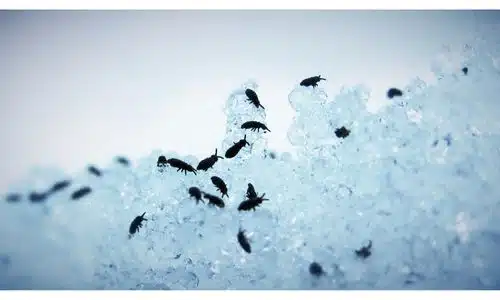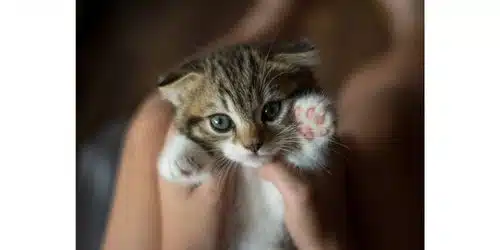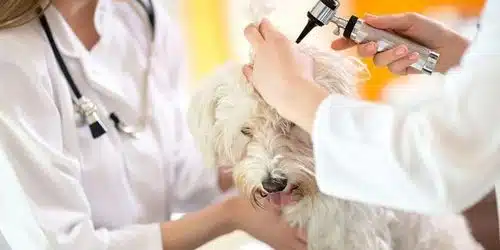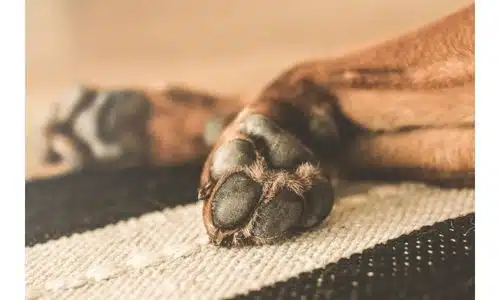You’ve probably encountered flea dirt and wondered how to get rid of it if you have cats or dogs, or if you have friends who do. It’s the tiny black specks you’ve probably noticed or felt while petting almost any furred animal. It could be in or around your cat’s or dog’s sleeping area (including your bed if he or she sleeps there), in the flea comb after grooming, or under your fingernails, if you just scratched your cat or dog behind the ears. In this post, we’ll look at what flea dirt is, how to test it, and how to get rid of fleas on dogs and cats.
The good news is that flea dirt is not harmful to you or your pet, and it is not the cause of flea allergies. This is caused by flea bites and appears to be an allergic reaction to the pest’s saliva. The bad news is that it indicates that you have fleas on your pet or in your home, or more likely, both.
What is a Flea Dirt
According to Dr. John Howe, DVM, president of the American Veterinary Medical Association, flea dirt is a combination of blood meal and flea feces. It’s essentially the waste fleas leave behind after consuming your pet’s blood.
Take heart now that you know what flea dirt is.
This icky stuff has one advantage: It’s easy to find. Because fleas are so small and move so quickly, they can be difficult to detect. Flea dirt, on the other hand, remains in one location, making it a clear warning sign. Finding flea dirt on your cat or dog may help you realize you have a flea problem before it gets out of hand if you don’t know how to get rid of it.
Tick poop, on the other hand—yep, we’re going there—is a different story. It is less likely to be discovered before the ticks. Tick excrement is not something I routinely look for or expect owners to look for in their pets. Ticks that remain attached to animals can and will defecate, but it is not as common on the skin as flea droppings or flea ‘dirt.’
What Does Flea Dirt Look Like?
According to Dr. Howe, flea dirt is dark, even black in some cases, and appears as small flecks or clumps. It can be found on any part of your pet, but it is most commonly found on their backs and bellies. Keep in mind that because cats are such meticulous groomers, it may be more difficult to detect fleas and flea dirt on them than on dogs.
What flea dirt looks like is regular dirt, and it’s easy to confuse the two. But there is a simple way to tell them apart. “Because fleas feed on blood from the pet, this blood is passed in their droppings,” Dr. Clark explains. Wetting flea dirt and wiping it on a white surface to see if it looks red, like blood, is one way we distinguish it from regular dirt.
Where Can Flea Dirt Be Found on Dogs and Cats?
Flea dirt is found on flea-infested dogs and cats. It is most visible in areas of thin or light-colored hair, as well as areas where fleas are frequently concentrated. Flea dirt can be found on the dog’s dorsal back (just cranial to the tail).
Flea dirt can also be found in your dog’s bedding. Place a dog on a white blanket, sheet, or towel and pet him or her while keeping an eye out for small black flakes to fall onto the white surface.
How Can You Tell If It’s Flea Dirt?
Fleas feed on blood. So digested blood is the main component of flea feces. It can be found by separating the hair and inspecting the skin. A flea comb can also be used. A flea comb is a fine-toothed comb that is used to remove small objects such as fleas or flea dirt.
Place any flea dirt you find on a moistened paper towel. When the flea dirt softens, it will have reddish or brown spots. This will assist you in distinguishing flea dirt from regular dirt specks.
What is the Significance of Flea Dirt on Dogs or Cats?
Flea dirt indicates that your dogs or cats have fleas. Some dogs are very good at grooming and then eating fleas, so you may not see them. There are 200 life forms in your home, carpet, or yard for every live flea you see on your dog or cat.
Does Flea Dirt Mean an Infestation?
Many pet parents wonder if their pets can have flea dirt but not fleas. No, thank you. When you find flea dirt on your cat or dog, you can’t assume it was just a pest problem.
That means they’ve had plenty of time to reproduce. Female fleas can lay eggs two days after feeding, according to Dr. Jennifer Coates, DVM, of Fort Collins, Colorado. She goes on to say that flea eggs are nearly impossible to find. Even if you don’t see any live fleas, flea dirt indicates that they’re most likely hiding somewhere on your pet.
Flea Dirt Test
Because blood is the main ingredient, you can use a flea comb to locate suspected flea dirt. Lift some of the skin’s dark specks and place them on a moist paper towel. If it is truly flea dirt, it will hydrate into reddish or brown spots on the wet towel.
What Happens Now That Flea Dirt Is Confirmed?
If you’ve determined that your dog is infested with fleas, it’s critical to act quickly. There are probably 200 live fleas in your home, carpet, or yard for every flea you find on your dog.
Many dogs who are “flea allergic” experience severe itching even from minor flea bites. They are extremely uncomfortable because they are hypersensitive to the antigens in flea saliva. Consult your veterinarian for a treatment plan, which may include antihistamines or even steroids.
Flea Dirt Bust No Fleas
There are times when you have flea dirt but no fleas. What makes this possible? The fleas were once present but have since jumped off or been destroyed by licking and grooming.
To get rid of flea dirt, bathe your pet first. Make it a habit to comb and brush your pet daily. Also, vacuum every day and clean carpets, furniture, and floor crack to remove any fleas and eggs that may be hiding. Don’t forget to wash pet beds, toys, and blankets, which can harbor fleas and flea dirt as fleas migrate from host to host and location to location.
Why do I see Flea Dirt but no Fleas?
The simple answer is that fleas can move, but flea dirt cannot. When you pet your dog or cat or move their bed, you can still see and/or feel the flea dirt. The living fleas, on the other hand, can simply jump away and out of sight. However, whether you see the fleas or not, if you find flea dirt on your pet or in its bedding, you have a flea problem.
How to Get Rid of Flea and Dirt
Flea dirt is not difficult to remove on its own. It’s a little more difficult to keep it away. More on that in a moment.
Removing from your dog or cat
This is as simple as giving your pet a thorough bath, paying special attention to the face and head as this is where fleas tend to flee. You can use any mild dog shampoo, but one that keeps fleas away is best. If there is a lot of flea dirt in the rinse water, it may turn reddish or pink. Don’t worry, this is normal and doesn’t mean that your dog is hurt or bleeding. If your dog has thick or long hair, brush or comb it to remove any dirt that the rinsing did not remove. A good flea comb will remove most flea dirt as well as any fleas in between baths.
Removing from your home
Clothing, bedding, and slipcovers with flea dirt can be washed. This isn’t limited to your belongings; wash the dog’s or cat’s bed as well! If these items have a lot of flea dirt on them, it is best to shake them off outside before putting them in the machine.
There is no need for any special soaps or insecticides. Flea dirt can be vacuumed up from furniture, rugs, and even the cracks in hardwood or tile floors. Mopping is not recommended because wet flea dirt leaves red smudges.
All of these measures are only temporary solutions to the problem’s root cause, the flea infestation, and dirt.
How to Treat Your Home for Flea Dirt
Cleaning, cleaning, cleaning. Hall says, “All bedding should be washed, and carpets should be vacuumed more than once to get rid of flea feces, eggs, and larvae.”
Keep in mind that fleas can live their entire life cycle indoors. “The highest levels of these immature flea stages are often found inside and can be found in carpets and wood floors,” she adds. Look for areas with sand and/or organic material, such as shaded areas outdoors, which she says are preferred by immature flea stages.
How to Prevent Fleas and Flea Dirt
Hall claims that these bloodsuckers affect both dogs and cats, even though the most common flea causing problems in North America is the “cat flea,” Ctenocephalides felis felis.
She adds that the best way to get rid of fleas and flea dirt is to follow a consistent and strict flea protocol all year. That means giving them flea prevention treatment all year, not just during the warmer months. Immature flea stages thrive in 70–80 percent humidity and 70–80 degree temperatures, so you may need to adjust the humidity and temperature in your home as well.
If you or your pet are dealing with fleas and their feces, Hall suggests consulting with a veterinarian to help you find solutions to eliminate and prevent future flea infestations in your home and on your pets.
Is flea dirt indicative of an infestation?
The short answer is that you should be concerned about a flea infestation for a variety of reasons. To begin, the presence of flea dirt on your dog or cat is a strong indicator that your pet is hosting one or more live fleas that have laid eggs.
Is flea dirt harmful to humans?
Even though flea dirt probably isn’t dangerous, it is a waste of insects and should be handled with care.
Does flea dirt have flea eggs in it?
People frequently confuse “flea dirt,” or flea feces, with flea eggs, even though both are signs of a flea infestation. Flea dirt, unlike flea eggs, is dark and crumbly. Put a few specks of flea dirt on a white piece of paper and add a few drops of water to identify it.
Is flea dirt eggs or poop?
Flea Eggs
People frequently confuse “flea dirt,” or flea feces, with flea eggs, even though both are signs of a flea infestation. Flea dirt, unlike flea eggs, is dark and crumbly. Put a few specks of flea dirt on a white piece of paper and add a few drops of water to identify it.
Why am I finding flea dirt but no fleas?
There are times when you have flea dirt but no fleas. What makes this possible? The fleas were once present but have since jumped off or been destroyed by licking and grooming. To get rid of flea dirt, first, give your pet a bath.
Can flea dirt go away by itself?
The first step is to use a non-irritating shampoo. “Flea dirt should be washed off the pet with a thorough bath, and two or three rounds of shampooing may be necessary for severely affected pets,” Hall says. “You can also use a flea comb (a small, fine-toothed comb) to tease dirt and live fleas out of your hair.”
Conclusion
Fleas are annoying, hard to get rid of, and dirty. They leave a nice trail of flea dirt in your pet’s fur and on your furniture. The good news is that this substance can be a good way to tell if you might have a flea problem. Once you’re aware of this, you can take the necessary steps to eliminate the problem and, hopefully, keep it from recurring in the future.
Frequently Asked Questions
Does flea dirt mean the fleas are gone?
“Flea dirt is actually adult flea feces,” Hall explains. “If you find flea dirt on your pet, it means your pet has fleas, and fleas only produce flea dirt after they’ve been on your pet long enough to consume and digest a blood meal (via biting).”
Does flea dirt hatch into fleas?
The larvae will spin a cocoon and enter the pupa stage after 5-20 days of feeding on flea dirt. The cocoon shields the pupa from environmental factors and insecticides/repellents for several days or weeks until adult fleas emerge.
Can flea dirt transfer to humans?
Cat scratch disease (CSD) is most commonly transmitted to humans through a scratch from a domestic or feral cat infected by a Ctenocephalides felis flea, or through flea feces (poop; also known as “flea dirt”) inoculated through a cat scratch. CSD occurs wherever there are cats and fleas.






